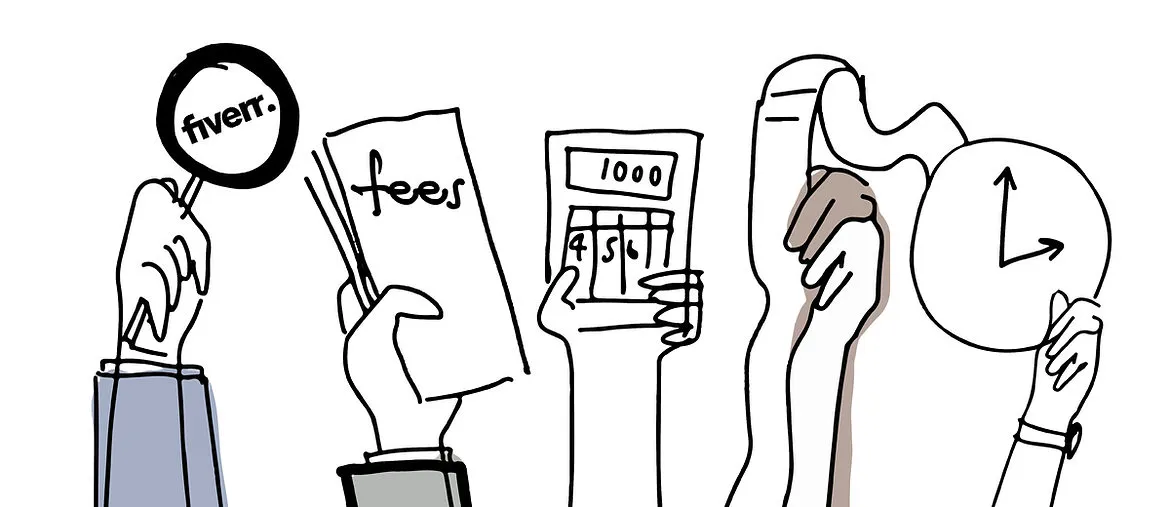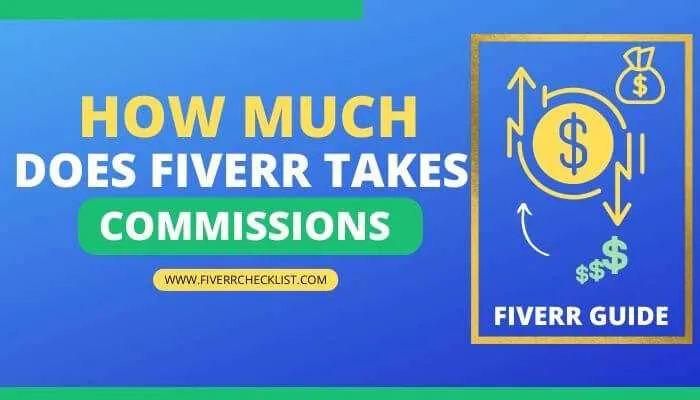When it comes to freelancing platforms, Fiverr has become one of the most popular choices for both buyers and sellers. If you're considering offering your services on Fiverr, one of the biggest questions you might have is: how much does Fiverr charge its sellers? Understanding the fees associated with selling can help you better prepare for your Fiverr journey and maximize your earnings. In this post, we'll break down the seller fees on Fiverr, so you can grasp why they exist and how they impact your overall income.
What is Fiverr?

Fiverr is an online marketplace that connects freelancers with clients seeking services across various industries. Founded in 2010, it initially began as a platform where services could be offered starting at just $5. Today, Fiverr has evolved to allow sellers to set their own prices, which can range from as low as $5 to thousands of dollars, depending on the complexity and scope of the service.
Whether you're a graphic designer, writer, musician, or programmer, Fiverr offers a space for you to showcase your skills and find potential clients from all around the globe. Here are some key features that make Fiverr stand out:
- Diverse Categories: Fiverr encompasses a wide range of categories, including graphic design, digital marketing, writing, video editing, and more.
- User-Friendly Interface: The platform is designed to be intuitive, making it easy for sellers to create profiles and list their services.
- Global Reach: With millions of users worldwide, Fiverr provides sellers with access to a vast client base.
- Reviews and Ratings: Clients can leave reviews, helping sellers build credibility and attract more business.
In a nutshell, Fiverr is not just a place to find quick gigs; it’s a thriving community where talent meets opportunity, and where sellers can turn their passions into profitable careers.
Also Read This: How to Access Lists on Fiverr
Overview of Fiverr Seller Fees

When you're selling your services on Fiverr, it's crucial to understand how their fee structure works. This is not just about making sales but ensuring that you know exactly how much you'll take home after Fiverr takes its cut. So, let’s break it down together!
Fiverr operates on a commission-based system, meaning they take a percentage of your earnings from each transaction. This can feel a bit like a toll—necessary for the platform’s services but something every seller should budget for. The standard fee is *20% of your earnings from each order, which means if you sell a gig for $100, Fiverr takes $20, leaving you with $80.
It's important to note that this fee structure applies uniformly to all sellers, regardless of their level or experience. There are no hidden fees, and that’s one aspect many sellers appreciate. However, there are additional factors at play when it comes to withdrawing your earnings, which can introduce some extra charges you should be aware of.
As a seller, you'll also benefit from Fiverr’s extensive reach, built-in marketing, and secure payment processing. Factoring in these benefits makes the fee seem more reasonable—but always keep the percentages in mind! So, ready to dive deeper into the types of fees Fiverr charges sellers? Let’s go!
Also Read This: How to make a full-time income on Fiverr
Types of Fees Fiverr Charges Sellers

Fiverr employs several fee types that sellers should be aware of to manage their finances effectively. Let's break these down into bite-sized pieces!
- Commission Fee: As mentioned earlier, this is the standard fee of 20%* deducted from every order. This is Fiverr’s primary source of income and covers platform maintenance, marketing, and customer support.
- Processing Fees: Depending on your withdrawal method, you might encounter processing fees. For instance, withdrawing via PayPal can incur a small fee, whereas bank transfers can also vary in cost. Always check the specifics that apply to your chosen method.
- Gig Extras Fees: If you choose to offer add-ons to your services (like express delivery or additional revisions), these too can incur the same 20% commission when sold. It's essential to factor these into your overall pricing strategy.
- Currency Conversion Fees: Selling on Fiverr may mean dealing with different currencies, particularly if you're serving a global audience. Currency conversion can occasionally attract fees, which is something to keep an eye on, especially depending on where you’re located.
Understanding these different types of fees will not only help you set your prices better but can also aid you in predicting your net earnings. So now that you know the lay of the land, you can focus more on what you do best: delivering amazing gigs!
Also Read This: Understanding the Process for Delivering and Getting Paid on Fiverr
5. Breaking Down the Fees

Understanding the fees on Fiverr is crucial for anyone considering selling their services on the platform. You might be wondering, what exactly do sellers get charged? Well, let’s break it down.
When a seller completes an order, Fiverr takes a commission from the total sale price. Here’s a simple breakdown:
- Service Fee: Fiverr charges a 20% commission on the total amount a seller earns from a completed order. For example, if you charge $100 for your service, you will keep $80, and Fiverr retains $20.
- Withdrawal Fees: When you transfer your earnings from Fiverr to your bank account or another payment method, there may be additional fees involved. Depending on the withdrawal method chosen, these can vary:
| Withdrawal Method | Fee |
|---|---|
| PayPal | Usually free, but depends on PayPal's terms. |
| Bank Transfer (Direct Deposit) | $1 |
| Fiverr Revenue Card | Varies; typically $3 per withdrawal. |
Additionally, it’s important to consider that sellers are responsible for any taxes applicable to their earnings, depending on their location. Understanding these fees can help you set your prices more accurately and retain as much of your earnings as possible.
Also Read This: How to Start Working as a Freelance Makeup Artist
6. How Fees Impact Seller Earnings
Now that we’ve unpacked the fees, let’s discuss how these charges impact a seller’s overall earnings on Fiverr. This is a vital aspect to consider, especially if you're looking to maximize your income.
With Fiverr taking 20% off the top, it’s important to consider the full effect on your pricing. Here are a few key points to keep in mind:
- Pricing Strategy: If you want to maintain a certain income level, you’ll need to factor in Fiverr’s fees when setting your prices. For example, if your target income for a specific service is $80, you'll need to charge $100 to cover Fiverr’s cut.
- Volume vs. Price: Some sellers opt for higher volume and lower prices to offset the impact of fees. However, this strategy might mean spending more time fulfilling orders for less reward.
- Market Competition: You’ll also need to consider competition within your niche. Researching similar services can help you find a competitive price point that still covers your fees and desired profit margin.
Ultimately, understanding how Fiverr’s fees impact your earnings will help you make strategic decisions about pricing and service offerings. Many successful sellers learn to navigate these waters early on to ensure they can sustain their business in the long run. Keeping a close eye on your profits will lead to smarter choices and a healthier bottom line!
Also Read This: Page Duplication Hack: Duplicating Pages in Canva Simplified
Tips for Maximizing Earnings on Fiverr
When you're on Fiverr, it’s crucial to not just list your services but to truly stand out. Here are some tips to help you maximize your earnings:
- Optimize Your Profile: Your profile is your first impression! Ensure it includes a professional photo, a compelling bio that highlights your skills, and samples of your best work. A well-crafted profile can significantly influence potential buyers.
- Create Multiple Gigs: Don’t put all your eggs in one basket. Think about creating multiple gigs related to your skills. This way, you can attract different types of buyers and increase your overall earnings.
- Set Competitive Prices: Research similar gigs to find the right price point. While it’s essential not to undervalue your work, competitive pricing can help you attract more clients, especially when starting out.
- Utilize Packages: Consider offering tiered packages (basic, standard, premium). This allows buyers to choose what best fits their needs and can drive more sales. Make sure each package has distinct features to justify the price differences!
- Focus on Customer Service: Prompt communication and excellent service can result in positive reviews. Happy customers are likely to return and refer others! Don’t be afraid to go the extra mile.
- Promote Your Gigs: Use social media and other platforms to promote your services. Share your Fiverr link and showcase your work. Effective promotion can expand your reach beyond Fiverr.
- Leverage Fiverr’s Promoted Gigs: If you're ready to invest a little, consider using Fiverr’s promoted gigs feature. This could place your gigs front and center, increasing visibility and potential sales.
Conclusion
Understanding how Fiverr charges sellers is essential for anyone looking to utilize the platform effectively. By grasping the fee structures, you can plan your prices and expectations accordingly. Remember, while Fiverr does take a cut from your earnings, the exposure and reach you get are incredibly valuable.
Keep in mind the strategies discussed to maximize your earnings. Whether it’s optimizing your profile, setting competitive prices, or delivering outstanding customer service, every little effort counts towards building a successful freelancing career on Fiverr.
Ultimately, while fees may seem daunting initially, they are part of a larger ecosystem that allows you to connect with a global audience. Embrace the platform, leverage its features, and with time, you might find that the potential for earnings is limitless!



